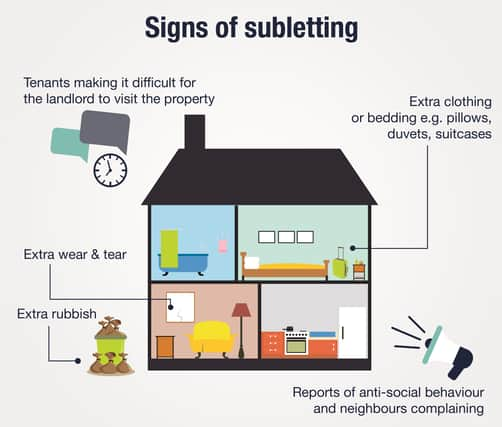The tell-tale signs of subletting


Subletting without any agreement is against the law. However, tenants are still doing it.By subletting without permission the tenants are in breach of the tenancy agreement, entitling the landlord to take legal action and could even result in eviction.This raises a number of potential issues, including debt, accountability and maintenance.A sublet property can also be detrimental to the landlord, as it may void any insurance policy they have on the property.Michael Cook, lettings managing director at Romans, said: “Illegal subletting is very detrimental to the landlord and tenants’ welfare and is a matter that Romans takes very seriously.“We take precautionary measures including background checks on all potential tenants and ensure the tenancy agreement is approved by a legal professional.“On top of this, we carry out inspections on a regular basis to check for signs of subletting, such as extra toothbrushes, suitcases or extra clothing.”Without having to become a detective, there are often tell-tale signs that indicate that the tenant might be subletting;Extra rubbishExtra clothing or bedding, for example; pillows, duvets, suitcases or extra toothbrushesExtra wear and tear to the propertyReports of anti-social behaviour from the neighboursNeighbours complaining about how many people are coming and going from the propertyTenants making it difficult for the landlord to visit the propertyIf the landlord believes that their tenant is subletting they must let their letting agent know straight away and take relevant action; remember landlords must end the original tenancy legally before agreeing a new one.“Very rarely does this situation arise but, if it does, we will step in on behalf of our fully managed landlords,” adds Michael.“We take action straight away and, after the original tenant has been notified, we will take the appropriate action.”You should note that, subletting can sometimes be allowed, with the landlord’s permission and a clause in the tenancy agreement.If the tenant would like to sublet, they should make a written request explaining the reasons to the landlord and allow a reasonable amount of time for them to reply to the request.If the landlord agrees then there should be new terms and conditions formulated.However, if the landlord does not agree the explanation should be in writing.A spokesman for Citizens Advice said: “When renting accommodation many tenants rent directly from a landlord who owns the property. However, it’s also possible to rent from another tenant who has rented the property from the owner. This is called subletting. Most tenants need their landlord’s permission before they can sublet all or part of their home. Tenancy agreements often contain a term on this, so you should always check your agreement first.”Find out more by calling 01344 985 870.